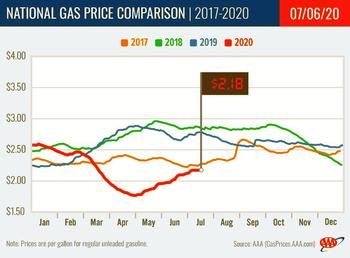
Publisher:
Bonnie King
CONTACT:
Newsroom@Salem-news.com
Advertising:
Adsales@Salem-news.com

~Truth~
~Justice~
~Peace~
TJP
Jul-07-2020 13:16

 TweetFollow @OregonNews
TweetFollow @OregonNews
Gas Prices Stay Fairly Steady in all 50 States
Salem-News.com BusinessFor the week, the national average remains at $2.18 a gallon. The Oregon average adds two cents to $2.61.
 National gas price comparison. Image: AAA |
(PORTLAND, Ore.) - Gas prices are fairly steady in all 50 states with increases or decreases of a nickel or less. For the week, the national average remains at $2.18 a gallon. The Oregon average adds two cents to $2.61.
U.S. gasoline demand shows a slight drop of 47,000 b/d while gasoline stocks increased by 1 million bbl.
“This comes as many states including Oregon report increases in COVID-19 cases, which could be causing Americans to reconsider some outings,” says Marie Dodds, public affairs director for AAA Oregon/Idaho.
Drivers who hit the road for Independence Day found pump prices were about 60 cents a gallon cheaper than last year. The national average was the cheapest for the holiday since 2004 and the Oregon average was at its cheapest since 2016.
Beyond typical fluctuation at the pump, on the week a few states saw prices jump due to fuel tax increases on July 1. This includes California, Illinois, Indiana, Iowa, Nebraska, South Carolina and Maryland.
Here in Oregon, traffic volumes are steadily increasing. The most recent traffic volume report (July 2, 2020) from the Oregon Department of Transportation shows the most recent full week saw an average reduction of 13 percent in weekday traffic volumes and a 20 percent reduction in weekend volumes overall compared to the previous year.
For the month of April, traffic began with 43 percent lower weekday volumes and 55 percent lower weekend volumes than 2019. See Report: www.oregon.gov/odot/Data/Documents/ODOT_TrafficReport_July%202_2020.pdf
Oregon is one of 34 states and the District of Columbia with higher prices now than a week ago but all of the increases are moderate. Nebraska (+5 cents) has the largest weekly increase. Indiana (-4 cents) has the largest week-over-week decrease. Prices are flat in Georgia.
For the fourth week in a row, Hawaii ($3.23) and California ($3.10) are the only two states in the nation with an average at or above $3 a gallon.
The cheapest gas in the nation can be found in Mississippi ($1.83) and Louisiana ($1.85). This is the 17th week in a row that one or more states has an average below $2 a gallon. In all, 12 states are below that benchmark, same as a week ago.
All 50 states and the District of Columbia have higher prices now than a month ago. The national average is 16 cents and the Oregon average is 13 cents more than a month ago.
This is the 39th-largest monthly increase in the country. Montana (+28 cents) has the largest month-over-month increase while Utah (+2 cents) has the smallest.
All 50 states and the District of Columbia have lower prices now than a year ago. The national average is 58 cents less and the Oregon average is 60 cents less than a year ago.
This is the 16th-largest yearly drop in the nation. Alaska (-74 cents) has the largest year-over-year drop. Colorado (-23 cents) has the smallest.
West Coast
The West Coast region continues to have the most expensive pump prices in the nation with every state in the region except Arizona in the top 10. Increases in pump prices across the West Coast region slowed last week, and prices are likely to continue that trend this week.
Hawaii is most expensive for the 30th week in a row. As mentioned above, Hawaii and California are the only two states in the nation with an average at or above $3 a gallon.
Washington, Nevada, Oregon, and Alaska round out the top 6. Arizona is 11th. Oregon is fifth most expensive for the third week in a row.
Hawaii (+4 cents) has the largest weekly increase in the region. Arizona (+1/10 cent) has the smallest week-over-week increase in the region.
According to EIA’s latest weekly report, total gas stocks in the region increased from 29.8 million bbl to 30.3 million bbl last week. Increasing stocks will likely contribute to slowing pump price increases this week in the region.
Oil market dynamics
Domestic crude prices increased after EIA’s weekly report revealed that total domestic crude inventories fell by 7.2 million bbl to 533.5 million bbl.
Decreasing crude stocks could mean that crude production is meeting demand as it continues to recover amid new coronavirus outbreaks around the world, which could suppress global crude demand during the second half of 2020.
At the end of Friday’s formal trading session, WTI increased by 83 cents to settle at $40.65 per barrel. At the end of Monday’s formal trading session, WTI fell two cents to settle at $40.63 per barrel.
Today crude is trading around $41 compared to $40 a week ago. Crude prices are up about seven percent in the last month and are about $17 less than a year ago.
Diesel
For the week, the national average remains at $2.44 a gallon. Oregon’s average holds steady at $2.61. A year ago the national average for diesel was just under $3.01 and the Oregon average was $3.20.
Find current fuel prices at GasPrices.AAA.com. Visit AAA.com/covidmap for an interactive map with the latest travel restrictions and policies for North America.
Source: AAA
Articles for July 6, 2020 | Articles for July 7, 2020 | Articles for July 8, 2020


googlec507860f6901db00.html



Terms of Service | Privacy Policy
All comments and messages are approved by people and self promotional links or unacceptable comments are denied.
[Return to Top]
©2026 Salem-News.com. All opinions expressed in this article are those of the author and do not necessarily reflect those of Salem-News.com.